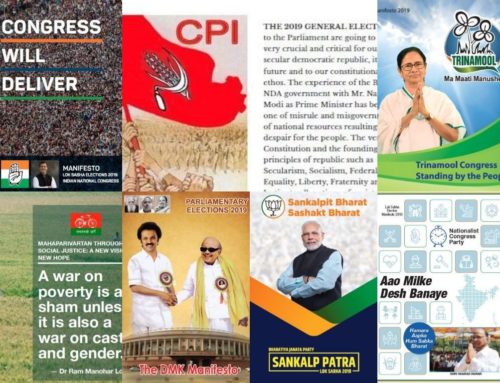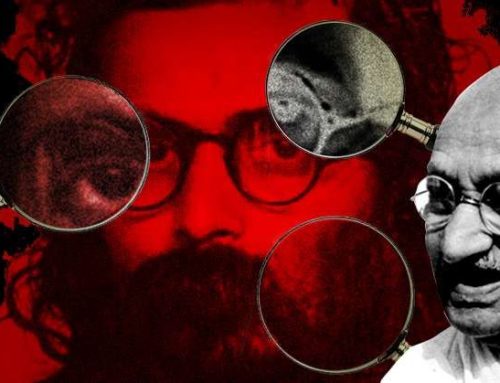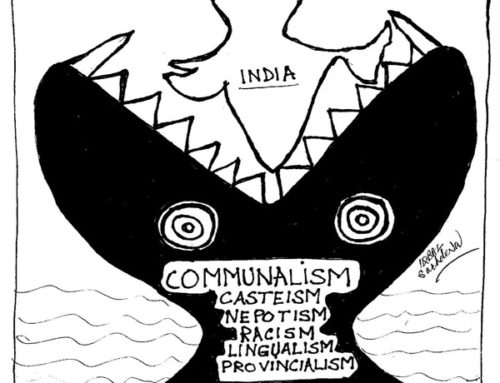“NUCLEAR FETISHISM SWAYING THE RULERS IN SOUTH ASIA”
Pratiksha Nair[i]
(Secular Perspective September 16-30, 2016)
Guggenheim Fellowship recipient and prominent nuclear physicist Dr. M. V.Ramana, attached to the Nuclear Futures Laboratory and Program on Science and Global Security at Princeton University, USA, delivering a lecture held last month at Mumbai Partakar Sangh on “Nuclear Weapons in South Asia: Programmes, Plans and Dangers,” questioned the nuclear fetishism swaying the rulers in the Indian sub-continent.
Author of The Power of Promise: Examining of Nuclear Energy in India, Dr. Ramana, last month in his talk organised by Dr. Asghar Ali Engineer Memorial Advisory Committee and Coalition for Nuclear Disarmament and Peace (CNDP) in memory of pacifist-journalist Praful Bidwai, interrogated the mad nuclear weapons race policies between the two neighbouring nations in South Asia and its dark implications.
Tracing the genesis of nuclear development in India, Dr. Ramana informed the gathering that barely a few months after India got sovereignty, an organization whose aim would be primarily the development of atomic energy was carved out via a Bill.
“…even though the decision to build nuclear weapons had not been taken, the option of building nuclear weapons was right in the DNA of the programme.”
Ironically, whilst the rulers fascinated by the potentiality of nuclear powers kept on harping that the development of atomic energy was solely for ‘peaceful purposes’ Prime Minister Jawaharlal Nehru in a candid moment conceded that he did ‘not know how to distinguish the two (peaceful and defence purposes)’.
The development of nuclear infrastructure by the Atomic Energy establishment interestingly took into account the possibility that the facilities constructed and expertise gained could be used for military purposes and the CIRUS reactor commissioned in 1960 and the Trombay Reprocessing Plant commissioned in 1964 allowed India to produce plutonium that could be used to make nuclear weapons.
However, even though the nuclear projects envisaged by the rulers had not gripped the public mind, the debate on developing nuclear weapons gathered momentum after the death of Nehru and the first Chinese nuclear weapon test in 1964. The debate primarily revolved around questions of security, cost, morality, and prestige.
However, even the discussions on the manufacturing of nuclear weapons was slowly building up, a series of developments eventually led to nuclear bomb test explosion in 1974 in Pokharan. Ironically the government described the test as ‘a peaceful nuclear explosion test’.
Incidentally, the timing of the test coincided with the creation of Bangladesh after Indo-Pak 1971 war. Going by the timing of the first nuclear bomb test in the Indian sub-continent, Ramana averred that that the decision to carry out the nuclear bomb test explosion was not taken in a moment of insecurity, but to assert supremacy in the Indian sub-continent in the wake of breaking up of Pakistan- India’s chief regional rival- into two countries. The timing of the test also undermines the argument of nuclear votaries and apologists who see China’s nuclear test explosions as a cause for India’s inclination and fascination towards nuclear weapons.
Although, India did not follow the path taken by other nuclear weapon states and weaponise its nuclear design, the weapons program never stopped after the 1974 test. Instead, the nuclear establishment refined nuclear weapon designs and lobbied for more weapons tests. A missile programme was also set up that resulted in the design and production of the Prithvi and Agni missiles that could deliver nuclear weapons.
During the 1990s, increased activity by the pro-nuclear bomb lobby led India voting against the Comprehensive Test Ban Treaty (CTBT). Interestingly, the rise of pro-nuclear voice in the corridors of powers was concomitant with the rise of Hindu Supremacists and the Bharatiya Janata Party who with their militarist and fascist worldview soon after coming to power created conditions for the May 1998 nuclear test explosion including a claim of a successful test of boosted/thermonuclear weapon (hydrogen bomb).
Delineating the nuclear programme in Pakistan, Dr. Ramana pointed out that during the Cold War era USA developed a strategic relationship with the neighbouring nation so as to have its own axis of power in South Asia.
Pakistani scientists were first trained by the United States as part of its Atoms for Peace Programme. After the 1965 India-Pakistan war, wherein USA eschewed aid to the latter (whereas China did), some Pakistanis, in particular Pakistan’s Foreign Minister Z.A. Bhutto, called for a ‘nuclear bomb’.
This post-1971 war call led to the launching of a nuclear weapon program in 1972 and after the 1974 Indian nuclear test whereby the US ceased its nuclear cooperation, Netherland based Pakistani metallurgist A.Q. Khan, offered his services to develop Pakistani nuclear programme by setting up a Uranium enrichment programme.
Revelation about this secret programme resulted in USA imposing sanctions on Pakistan which was reversed after the Soviets invaded Afghanistan in 1979 and then re-imposed in 1989 after Soviets left Afghanistan. But in the interim period Pakistan produced highly enriched Uranium and developed bomb designs that were tested in May 1998.
In the aftermath of the 1998 nuclear tests, both India and Pakistan have been involved in the creation of doctrines and command structures to plan for the potential use of nuclear weapons. In India, the military has gained greater control of nuclear weapons. Peace talks between the countries have primarily been attempts at proving that India and Pakistan are responsible states but no substantial measure has been agreed upon.
As of 2014, the estimate of weapon-grade plutonium in India is around 600 kilograms. About 5 kg is sufficient for one nuclear weapon. The estimated stockpile of Highly Enriched Uranium (HEU) as of the end of 2014 in India is 3.2 ± 1.1 tons with a U-235 content of 1.0 ± 0.3 tons. This is said to be primarily for the nuclear (Arihant) submarine programme. However, because the estimated stockpile vastly exceeds what might be needed for all envisioned nuclear submarines, it is possible that the HEU might be used in nuclear weapons. About 25 kg is sufficient to produce one nuclear weapon. For Pakistan, the stockpiles are estimated to be 3.1 ± 0.4 tons of HEU and 190 kg of plutonium as of the end of2014.
Going by the records of missile tests and purchase of nuclear weapon delivery vehicles, Dr. Ramana contended that India was in the process of developing two technologies that are profoundly destabilizing viz. Ballistic Missile Defence and Early warning systems which envisages setting up of radars and satellites to detect the launch and flight of missiles.
And although India has a ‘no first use’ policy, Dr. Ramana viewed it as one of those ambiguous commitments which rarely reflects the ground zero reality as ‘In principle, this policy means waiting for an incoming missile to explode before retaliating. But setting up early warning systems suggests that the leadership does not envision waiting for such an explosion and might launch missiles as soon as there is warning of an impending attack; in other words, it would no longer be a strict no first use commitment’.
Expressing apprehensions with regard to such systems, he said that early warning technology has great potential for errors and accidental launches and chilling examples from the Cold War era wherein U.S. leaders received false warnings indicating Soviet nuclear missiles were approaching the United States when there was actually no such attack underway is a case in point.
While the saving factor in the case of USA and the Soviet Union lay in the distance and time span, in the case of South Asia, ‘the two countries- India and Pakistan- share boundaries and the time taken by a missile from one country to hit the capital city of the other would be only 6-13minutes depending on the launch site. Once you take away the time it takes to detect the launch and confirm that the missile is indeed directed towards the other country, there would be barely a couple of minutes for the Indian or Pakistani leadership to make a decision to respond. Because any technology is capable of errors and accidents, deploying an early warning system will increase the risk of inadvertent or accidental nuclear war’.
“Both countries (India – Pakistan) are playing a game where they are lowering the threshold of using nuclear weapons, which is a profoundly dangerous and destabilizing situation.”
On the issue of deterrence theory, Dr. Ramana opined that with Pakistan realizing that its nuclear arsenal prevented India from launching a massive attack during Kargil war, it will start lowering the nuclear weapon use threshold especially in view of news reports indicating that Indian military has decided to shift from the defensive strategy to offensive operations at the onset of a conflict which in the final analysis was ‘…not only dangerous but may also end in a catastrophe for the entire region.’
On the issue of international powers influencing the politics in the sub-continent, Dr. Ramana delineated the role of USA and the dangers of a four-way race that has intensified in recent years. U.S.-Indo relations changed radically during the Bush administration (2000-08) as the former’s foreign policy was guided by neo-conservatives that saw the world in highly polarized terms.
China was perceived as the chief barrier to U.S. hegemony in the international world order and thus propping up of India became a necessity to counter China’s gradual increasing international economic power. It is the Sino-phobia that made US Secretary of State Condoleeza Rice, state in 2000: “India is an element in China’s calculation, and it should be in America’s, too. India is not a great power yet, but it has the potential to emerge as one.”
Under the 2004 Next Steps in Strategic Partnership, the United States agreed to help India with civilian nuclear activities, civilian space programs, dual-use high-technology trade and missile defence. In other words, India’s nuclear weapons ceased to be seen as something to be concerned about, and instead became seen as a necessity to keep China off balance. This policy has continued even in the Obama administration, which signed a Joint Strategic Vision for the Asia-Pacific and Indian Ocean Region. An important clause in the vision was the joint affirmation of “the importance of safeguarding maritime security and ensuring freedom of navigation and over flight throughout the region, especially in the South China Sea”. U.S. support for India’s NSG (Nuclear Suppliers Group) membership should be seen in this light.
“India’s only possible benefit of joining the NSG is purely symbolic – being able to sit at the high table with the big boys”
Deconstructing the media frenzy over India’s gain in becoming a NSG member, Dr. Ramana in his summing up averred that India has nothing to gain in material terms since it already had access to nuclear reactors and uranium and thus ‘…the only possible benefit is purely symbolic – being able to sit at the high table with the big boys. And what does India have to lose or pay to join NSG?… the stakes are quite clear – it is part of the United States’ ploy to get India on to their side against China in multiple spheres – diplomacy, NSG and even possibly the Security Council. The question then we need to ask ourselves is – is this the role India should be playing? Is this competition with China desirable?’
The session was chaired by Anand Patwardhan and Darryl D’Monte represented the Dr. Asghar Ali Engineer Memorial Advisory Committee on the dais. The audience consisted of students from various institutes, people engaged in anti-Jaitapur Nuclear Power Project struggles, professors and researchers. The question and answer session that followed the talk was wide-ranging, involving discussions about topics as varied as the relationship between deterrence and terrorism, and deontological issues associated with the production and disposal of radioactive waste described as ‘ a slow fuse miasmic time bomb that would keep on ticking for centuries spreading life-wasting corrosive noxious vapours silently’.
[i] Programme Coordinator, CSSS






